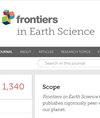从中国凌家滩考古遗址出土的烧焦粘土和陶器中提取的加热石英的发光年代测定
IF 2
3区 地球科学
Q3 GEOSCIENCES, MULTIDISCIPLINARY
引用次数: 3
摘要
本研究利用ls - sar、TL-SAR和TL-MAAD方法测定了中国凌家滩考古遗址燃烧粘土和陶器样品中提取的加热石英的年代。通过对CW-OSL曲线进行反卷积,确定了被加热石英的OSL组分,并利用Fast Ratio值来区分初始OSL信号是否以Fast组分为主。结果表明,初始信号中石英OSL有两种特征:ⅰ型以快组分为主(fast Ratio值为bbb10),ⅱ型以中、慢组分为主(fast Ratio值< 10)。I型样品显示明亮的OSL信号,并且在相对较低的温度下出现预热平台。在常规的光学光学光谱测量条件下,可获得可靠的等效剂量。相比之下,II型样品的OSL信号相对较暗,并且在比I型样品高得多的温度下出现预热平台。在较高的预热温度下,II型样品的回热显著增加。在较低的预热温度下观察到II型样品的显著De低估。结果表明,提高热释光激发温度可以减弱换热效应。因此,采用改进的ols - sar测量条件,采用更高的预热、切割和刺激温度,对II型样品进行测年。这两种样品的大多数ols - sar年龄与独立的14C年龄吻合得很好,表明ols - sar可以用于在高温(~ 900°C)下加热考古材料的年代测定。凌家滩考古遗址被确定为大约5.4-5.8 ka BP 2022。本文章由计算机程序翻译,如有差异,请以英文原文为准。
Luminescence dating of heated quartz extracted from burnt clay and pottery excavated from the Lingjiatan archaeological site, China
This study utilizes OSL-SAR, TL-SAR, and TL-MAAD methods to date heated quartz extracted from burnt clay and pottery samples from the Lingjiatan archaeological site, China. The OSL components of the heated quartz were determined by deconvoluting the CW-OSL curve, and the Fast Ratio value was used to distinguish whether the initial OSL signal was dominated by the fast component. The results show two types of quartz OSL characteristics in the initial signals: Type I is dominated by the fast component (Fast Ratio values > 10), while Type II is dominated by the medium and slow components (Fast Ratio values < 10). Type I samples show bright OSL signals, and a preheat plateau appears from a relatively low temperature. The recuperation is negligible, and reliable equivalent doses can be obtained using the conventional OSL-SAR measurement conditions. In contrast, the OSL signal of Type II samples is relatively dim, and the preheat plateau appears from a much higher temperature than in Type I samples. The recuperation of Type II samples increases significantly at higher preheat temperatures. Significant De underestimation of Type II samples was observed at lower preheat temperatures. It is noted that the thermal transfer effect can be attenuated by increasing the OSL stimulation temperature. Therefore, a modified OSL-SAR measurement condition, with higher preheat, cut-heat and stimulation temperatures, was used to date Type II samples. The OSL-SAR ages of most of these two types of samples agree well with the independent 14C ages, demonstrating that OSL-SAR can be used to date heated archaeological materials at high firing temperatures (∼900°C). The Lingjiatan archaeological site was determined to be approximately 5.4–5.8 ka BP 2022.
求助全文
通过发布文献求助,成功后即可免费获取论文全文。
去求助
来源期刊

Frontiers in Earth Science
Earth and Planetary Sciences-General Earth and Planetary Sciences
CiteScore
3.50
自引率
10.30%
发文量
2076
审稿时长
12 weeks
期刊介绍:
Frontiers in Earth Science is an open-access journal that aims to bring together and publish on a single platform the best research dedicated to our planet.
This platform hosts the rapidly growing and continuously expanding domains in Earth Science, involving the lithosphere (including the geosciences spectrum), the hydrosphere (including marine geosciences and hydrology, complementing the existing Frontiers journal on Marine Science) and the atmosphere (including meteorology and climatology). As such, Frontiers in Earth Science focuses on the countless processes operating within and among the major spheres constituting our planet. In turn, the understanding of these processes provides the theoretical background to better use the available resources and to face the major environmental challenges (including earthquakes, tsunamis, eruptions, floods, landslides, climate changes, extreme meteorological events): this is where interdependent processes meet, requiring a holistic view to better live on and with our planet.
The journal welcomes outstanding contributions in any domain of Earth Science.
The open-access model developed by Frontiers offers a fast, efficient, timely and dynamic alternative to traditional publication formats. The journal has 20 specialty sections at the first tier, each acting as an independent journal with a full editorial board. The traditional peer-review process is adapted to guarantee fairness and efficiency using a thorough paperless process, with real-time author-reviewer-editor interactions, collaborative reviewer mandates to maximize quality, and reviewer disclosure after article acceptance. While maintaining a rigorous peer-review, this system allows for a process whereby accepted articles are published online on average 90 days after submission.
General Commentary articles as well as Book Reviews in Frontiers in Earth Science are only accepted upon invitation.
 求助内容:
求助内容: 应助结果提醒方式:
应助结果提醒方式:


